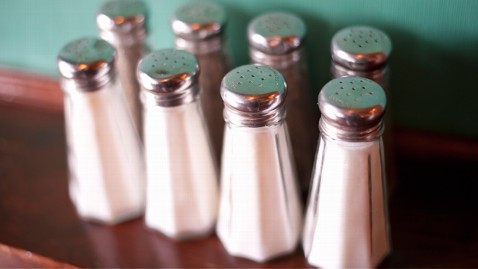1 in 10 U.S. Deaths Blamed on Salt
On the heels of a study linking sugary drinks to 25,000 U.S. deaths a year, new research suggests salty food is even more dangerous.
The new study, by the same Harvard research team, linked excessive salt consumption to nearly 2.3 million cardiovascular deaths worldwide in 2010. One in 10 Americans dies from eating too much salt, the researchers found.
"The burden of sodium is much higher than the burden of sugar-sweetened beverages," said Dr. Dariush Mozaffarian, an epidemiologist at the Harvard School of Public Health and author of both the salt and sugary drink studies. "That's because sugar-sweetened beverages are just one type of food that people can avoid, whereas sodium is in everything."
Mozaffarian and colleagues used data from 247 surveys on sodium intake and 107 clinical trials that measured how salt affects blood pressure, and how blood pressure contributes to cardiovascular disease like heart attacks and stroke.
"From that we could determine the health effects of sodium," he said, adding that one out of three deaths due to excessive sodium occurred before age 70. "It's really affecting younger adults, not just the elderly."
The study, presented today at the American Heart Association's annual meeting in New Orleans, adds to mounting evidence that packaged and processed foods containing high levels of salt for flavor and shelf life can take a heavy toll on cardiovascular health.
"It's really amazing how pervasive it is," Mozaffarian said of salt. "For the average person, it's very hard to avoid salt - you have to be incredibly motivated, incredibly educated, have access to a range of foods and do all the cooking yourself."
But not everything is easy to whip up at home, Mozaffarian added. Bread and cheese are the top two sources of sodium in the U.S.
"It's everywhere," he said.
For the study, the researchers set the ideal level of salt consumption at 1,000 milligrams per day - less than half of the upper limit recommended by the U.S. Centers for Disease Control and Prevention and less than a third of the average American intake.
The Salt Institute took issue with the unrealistic threshold.
"This misleading study did not measure any actual cardiovascular deaths related to salt intake, since, by the authors' own admission, no country anywhere in the world consumes the low levels of salt they recommend," Morton Satin, vice president of science and research for the Virginia-based institute said in a statement.
Satin also stressed that Mozaffarian's research is yet to be published in a peer-reviewed journal, and said it "reveals an agenda far more rooted in sensationalist politics than in science."
"The Salt Institute does not consider this misleading modeling exercise helpful in furthering our knowledge of the role of salt on our health," Satin said. "On the contrary, it is disingenuous and disrespectful of consumers."
Mozaffarian said he plans to submit the study for publication later this year, and stressed that politics has nothing to do with it.
"We have no vested interest in what the research shows," he said. "This is not sensational. The point is to objectively look at the impact of salt using the best possible science, and that's what we have done."
Mozaffarian said he hopes the study will impel policy makers to set sodium limits in prepared foods and make it easier for Americans to lower their salt intake. In the meantime, however, some smart shopping can help.

"One way you can have more control is to shop the perimeter of the supermarket," said ABC News' chief health and medical editor Dr. Richard Besser. "That's where you will find fresh fruits and vegetables, meats and dairy products. When you cook with these ingredients you have control over how much salt you take in."
Another tip: Read food labels. Table salt is listed as sodium chloride.
"You might be surprised at all the foods that have hidden salt," Besser said.
Karen Keller contributed to this story.

One in ten U.S. death are linked to salt, researchers say. (Image credit: Stockimage/Getty Images)